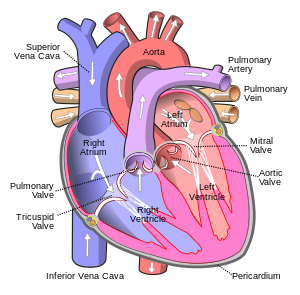
Back صمام رئوي Arabic Ağciyər kötüyü qapağı Azerbaijani Zalistak plućne arterije BS Vàlvula pulmonar Catalan Пехийн гӀодан деганегӀар CE Pulmonalklappe German Vàrvora pulmonèra EML Válvula pulmonar Spanish Birika-balbula Basque دریچه ریوی Persian
| Pulmonary valve | |
|---|---|
 Anterior (frontal) view of the opened heart. White arrows indicate normal blood flow. | |
 Heart seen from above. | |
| Details | |
| Identifiers | |
| Latin | valva trunci pulmonalis |
| MeSH | D011664 |
| TA98 | A12.1.02.010 |
| TA2 | 4008 |
| FMA | 7246 |
| Anatomical terminology | |

The pulmonary valve (sometimes referred to as the pulmonic valve) is a valve of the heart that lies between the right ventricle and the pulmonary artery, and has three cusps. It is one of the four valves of the heart and one of the two semilunar valves, the other being the aortic valve. Similar to the aortic valve,[1] the pulmonary valve opens in ventricular systole when the pressure in the right ventricle rises above the pressure in the pulmonary artery. At the end of ventricular systole, when the pressure in the right ventricle falls rapidly, the pressure in the pulmonary artery closes the pulmonary valve.
The closure of the pulmonary valve contributes to the P2 component of the second heart sound (S2).[2]
- ^ Stradins, P (September 2004). "Comparison of biomechanical and structural properties between human aortic and pulmonary valve*1". European Journal of Cardio-Thoracic Surgery. 26 (3): 634–639. doi:10.1016/j.ejcts.2004.05.043. PMID 15302062.
- ^ Sakamoto, Tsuguya; Matsuhisa, Mokuo; Hayashi, Terumi; Ichiyasu, Hirofumi (1975). "Echocardiogram and Phonocardiogram Related to the Movement of the Pulmonary Valve". Japanese Heart Journal. 16 (2): 107–117. doi:10.1536/ihj.16.107. PMID 1117589. Retrieved 4 December 2022.